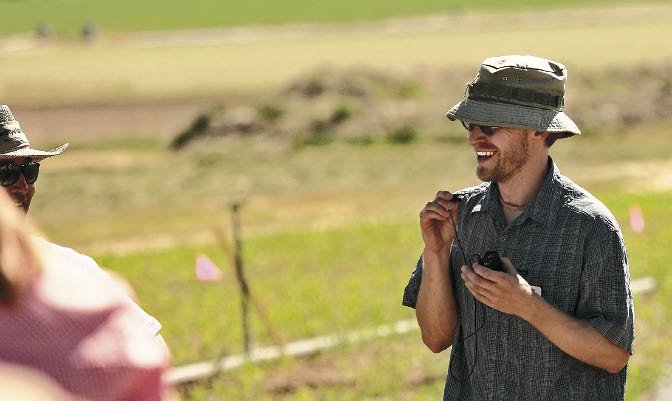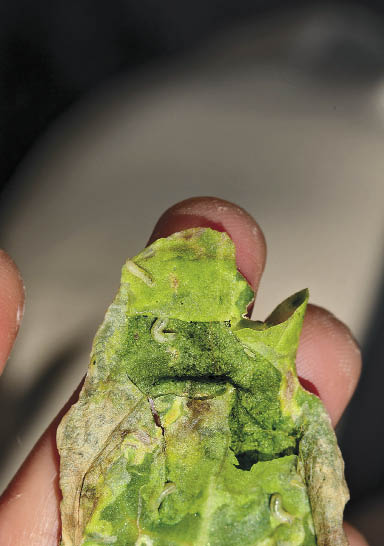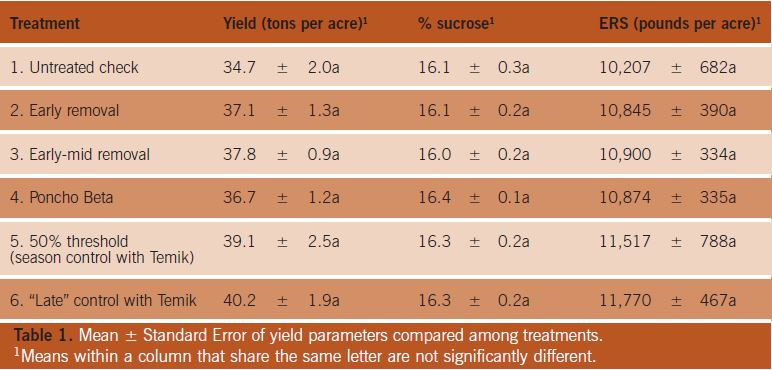
The second year of a field experiment was conducted to clarify the importance of damage from the beet leafminer to sugarbeet production in Idaho.
The study was designed to: (1) determine whether mid- to late-season damage from leafminers affects sugar yield, (2) experimentally evaluate the utility of proposed leafminer action thresholds in Idaho, and (3) determine the duration of control of leafminers using Poncho Beta seed treatment.
The experimental treatments established on field plots at the U-Idaho Kimberly R & E Center were as follows: (1) untreated check, (2) early-season leafminer removal (leafminer eggs physically removed from emergence until mid June), (3) early- to mid-season leafminer removal (leafminer eggs physically removed from emergence until early July), (4) Poncho Beta (clothianidin + beta-cyfluthrin) insecticide seed treatment, (5) 50 percent infestation threshold (i.e., applying Temik [aldicarb] when 50 percent or more of plants are infested with eggs or larvae), and (6) a "late" application of Temik (i.e., during the eight- to ten-leaf stage, which is thought to be the point at which leafminers are no longer causing economic damage to sugarbeet).
Weekly counts of larvae and eggs over twelve weeks indicated that the two removal treatments successfully protected plants from leafminer damage relative to the untreated check.
Poncho Beta treatment significantly reduced leafminer larvae relative to the untreated check at least until the end of June (i.e., about two months after planting), at which point there was no difference in the number of mines between the Poncho Beta treatment and the untreated check for the remainder of the season.
Temik was applied for the 50 percent threshold treatment plots on June 16 and remained effective against leafminers through the end of July.
The "late" application of Temik was made on June 24 and remained effective against leafminers through the end of July. By August leafminer densities were low across all treatments.

Neither clean yield (tons per acre), nor percent sucrose, nor Estimated Recoverable Sucrose (ERS) differed significantly among treatments (Table 1). However, there were numerical differences among treatments that reflected the expected trends.
Yields tended to be lowest for the untreated check, highest for the Temik treatments, and intermediate for the remaining treatments.
Because differences among treatments in regard to yield were also subtle in 2010, during 2011 additional tare samples were collected from each plot and stored within the outdoor beet storage pile in Twin Falls.
Samples were retrieved at ca. 40-day intervals beginning in December to conduct sugar analyses with the collaboration of Carl Strausbaugh (USDA-ARS, Kimberly, ID).
We hypothesize that subtle differences in sugar yield at harvest may become more pronounced over time in storage; however, the storage data have yet to be fully analyzed.
Weather during spring 2011 was unusually cool and wet, which delayed population development of leafminers; thus, populations were likely relatively small during the critical early growth stage of sugarbeets.
This study will have to be repeated at least one more season before definitive conclusions can be drawn.
Results thus far suggest that effects of beet leafminer flies on sugar yield are relatively small when considered alone, but even subtle effects on yield may be important, especially if it should turn out that leafminer damage compromises the ability of beets with withstand damage from other pests or to maintain sugar content in storage.
